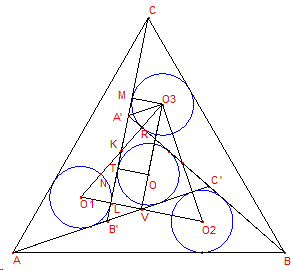Four Incircles in an Equilateral Triangle, a Sangaku
Elsewhere we described and solved the following sangaku:

In an equilateral triangle \(ABC\) the lines \(AB'C'\), \(BC'A'\), \(CA'B'\) are drawn making equal angles with \(AB\), \(BC\), \(CA\), respectively, forming the triangle \(A'B'C'\), and so that the radius of the incircle of triangle \(A'B'C'\) is equal to the radius of the incircle of triangle \(AC'B\). Find \(A'B'\) in terms of \(AB\).
Angela Drei, an Italian math teacher, has supplied (August 4, 2012) an additional proof that also confirms an observation about three pairs of parallel lines made on the original page.
Angela's proof also proceeds in steps.
Proposition 1
The triangle \(O_{1}O_{2}O_{3}\) is equilateral.
Proof: \(\Delta ABC'\) is obtained from \(ACB'\) by a \(120^{\circ}\) counter-clockwise rotation about the center of \(ABC\) and similarly \(CA'B\) is obtained by \(ABC'\), \(O_{1}\) is the center of the incircle of triangle \(AB'C\), by the previous rotation we obtain the centers \(O_{2}\) and \(O_{3}\), then the triangle \(O_{1}O_{2}O_{3}\) is equilateral.
Proposition 2
\(L\) (point of tangency) \(\in O_{1}O_{2}\). (Similarly, \(R\in O_{1}O_{3}\), where \(R\) is another point of tangency.)
Proof: \(OT\) and \(O_{3}M\) are perpendicular to \(CB'\), \(OO_{3}\) and \(MT\) are parallel because the distances \(OT\) and \(O_{3}M\) are equal, so \(\angle MKO_{3}=\angle KO_{3}O=30^{\circ}\), \(L\) is the point of intersection of \(MT\) and \(O_{1}O_{2}\), but \(O_{3}O\) is perpendicular to \(O_{1}O_{2}\) then \(ML\) is perpendicular to \(O_{1}O_{2}\), showing that \(L\) is the point of tangency.
Proposition 3
The side of \(O_{1}O_{2}O_{3}\) is four times \(r\), the radius of the incircles.
Proof: in right triangles \(O_{1}LK\) and \(O_{3}MK\), \(\angle MKO_{3}=\angle O_{1}KL\), as vertically opposite, and \(O_{3}M=O1L=r\), so that the triangles are congruent and \(K\) is the midpoint of \(O_{1}O_{3}\), \(\angle O_{1}KL=30^{\circ}\) as was already shown, and \(\angle KO_{1}L=\angle MO_{3}K=60^{\circ}\). Further, \(\angle A'O_{3}M=30^{\circ}\); triangles \(A'RK\) and \(A'RO_{3}\) are congruent. Indeed, they have \(A'R\) as common side, and \(A'R\) is perpendicular to \(KO_{3}\), making \(O_{1}O_{3}=4r\).
Now let \(A'B'=l\); \(l=A'K+KL+LB'\) and, as a consequence of the previous claims, we deduce \(A'K=\frac{2}{\sqrt{3}}KR=\frac{2}{3}\sqrt{3}r\), \(LB'=\frac{1}{2}\left(\frac{2}{\sqrt{3}}r\right)=\frac{1}{3}\sqrt{3}r\), and \(KL=\frac{\sqrt{3}}{2}2r=\sqrt{3}r\), so that \(l=2\sqrt{3}r\).
We consider the areas of the four triangles that form \(\triangle ABC\); the sum of their areas equals that of \(\triangle ABC\), but each can be calculated separately. The area of \(\triangle AB'C\) is \(xr+\frac{\sqrt{3}}{3}r^{2}\), where \(x\) is the side of \(\triangle ABC\). The area of \(\triangle A'B'C'\) is \(\frac{3}{2}lr\) and also \(l^{2}\frac{\sqrt{3}}{4}\), making \(r=l\frac{\sqrt{3}}{6}\). The area of \(\triangle ABC=x^{2}\frac{\sqrt{3}}{4}\). Summing up leads to the equation
\(3xr + \sqrt{3}r^{2} + \frac{3}{2}lr=\frac{x^{2}\sqrt{3}}{4}.\)
Replacing \(r=l\frac{\sqrt3}}{6} we obtain
\(3xl\frac{\sqrt{3}}{6} + l^{2}\frac{\sqrt{3}}{12} + \frac{\sqrt{3}}{4}l^{}=\frac{x^{2}\sqrt{3}}{4}.\)
Or, after simplification \(6xl+4l^{2}-3x^{2}=0\), with the only positive root \(l=x\frac{\sqrt{21}-3}{4}\).
(There is another proof by George Zettler and a third one by J. John Samuel.)
- Sangaku: Reflections on the Phenomenon
- Critique of My View and a Response
- 1 + 27 = 12 + 16 Sangaku
- 3-4-5 Triangle by a Kid
- 7 = 2 + 5 Sangaku
- A 49th Degree Challenge
- A Geometric Mean Sangaku
- A Hard but Important Sangaku
- A Restored Sangaku Problem
- A Sangaku: Two Unrelated Circles
- A Sangaku by a Teen
- A Sangaku Follow-Up on an Archimedes' Lemma
- A Sangaku with an Egyptian Attachment
- A Sangaku with Many Circles and Some
- A Sushi Morsel
- An Old Japanese Theorem
- Archimedes Twins in the Edo Period
- Arithmetic Mean Sangaku
- Bottema Shatters Japan's Seclusion
- Chain of Circles on a Chord
- Circles and Semicircles in Rectangle
- Circles in a Circular Segment
- Circles Lined on the Legs of a Right Triangle
- Equal Incircles Theorem
- Equilateral Triangle, Straight Line and Tangent Circles
- Equilateral Triangles and Incircles in a Square
- Five Incircles in a Square
- Four Hinged Squares
- Four Incircles in Equilateral Triangle
- Four Incircles in an Equilateral Triangle, a Sangaku
- Gion Shrine Problem
- Harmonic Mean Sangaku
- Heron's Problem
- In the Wasan Spirit
- Incenters in Cyclic Quadrilateral
- Japanese Art and Mathematics
- Malfatti's Problem
- Maximal Properties of the Pythagorean Relation
- Neuberg Sangaku
- Out of Pentagon Sangaku
- Peacock Tail Sangaku
- Pentagon Proportions Sangaku
- Proportions in Square
- Pythagoras and Vecten Break Japan's Isolation
- Radius of a Circle by Paper Folding
- Review of Sacred Mathematics
- Sangaku à la V. Thebault
- Sangaku and The Egyptian Triangle
- Sangaku in a Square
- Sangaku Iterations, Is it Wasan?
- Sangaku with 8 Circles
- Sangaku with Angle between a Tangent and a Chord
- Sangaku with Quadratic Optimization
- Sangaku with Three Mixtilinear Circles
- Sangaku with Versines
- Sangakus with a Mixtilinear Circle
- Sequences of Touching Circles
- Square and Circle in a Gothic Cupola
- Steiner's Sangaku
- Tangent Circles and an Isosceles Triangle
- The Squinting Eyes Theorem
- Three Incircles In a Right Triangle
- Three Squares and Two Ellipses
- Three Tangent Circles Sangaku
- Triangles, Squares and Areas from Temple Geometry
- Two Arbelos, Two Chains
- Two Circles in an Angle
- Two Sangaku with Equal Incircles
- Another Sangaku in Square
- Sangaku via Peru
- FJG Capitan's Sangaku
|Contact| |Front page| |Contents| |Geometry|
Copyright © 1996-2018 Alexander Bogomolny73558930
